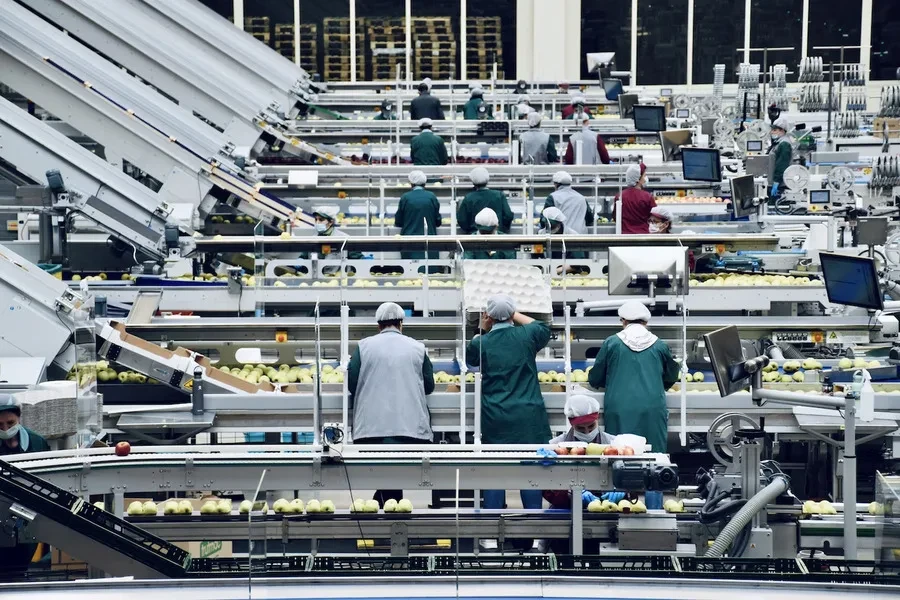The food packaging machinery industry has experienced a number of developments in recent years thanks to the adoption of new innovations, shaping how food products are packaged and delivered. These changes are propelled by technological advancements, demand for efficiency and sustainability, and evolving consumer preferences. This blog examines the latest trends in the food packaging machinery industry, providing insights that businesses can leverage to become more competitive.
Table of Contents
Food packaging machinery market
Top trends in the food packaging machinery industry
Conclusion
Food packaging machinery market
The global packaging machinery was valued at US $46.4 billion in 2022 and is projected to reach US $56.7 billion in 2027, growing at a CAGR of 4.1%, with the ongoing need for more advanced packaging in the food and beverage industry accelerating the demand for packaging equipment. Fortune Business Insights estimates that the global market for food packaging equipment will generate approximately US $23.03 billion in 2027.
Packaging machinery in the food industry is used for multiple purposes, including sealing, labeling, wrapping, filling, and palletizing. Food manufacturers need packaging equipment to protect food from pollutants as well as to improve productivity.
Other factors driving the market growth for food packaging equipment include:
- The rapid growth of the ecommerce sector and online food delivery services, increasing the need for packaging solutions and consequently driving demand for effective packaging machinery
- The need for intelligent packaging machines by manufacturers to improve work efficiency
- Consumer awareness and expectations for safe, innovative, and convenient packaging, which further prompts manufacturers to invest in machinery
- The demand for automation in the food and beverage sectors, aiding fast and accurate packaging practice
- Expansions of the global market mean that businesses are investing in appropriate packaging machinery to ensure the safe transportation and protection of food products
Top trends in the food packaging machinery industry
Recent years have seen numerous changes in the food packaging machinery market due to rapid technological growth and the need to adapt to modern consumer needs. The result is multiple new trends that businesses should follow in order to achieve long-term success and sustainability. These include:
1. Smart packaging systems
Food manufacturers are increasingly investing in smart packaging systems for their ability to track, monitor, and communicate critical information about the product in real time. These smart packaging systems are integrated with advanced technologies such as wireless communication and cloud data solutions, providing access to features that improve product safety and traceability across the supply chain. Smart packaging machines are also equipped with features that facilitate quality information exchange and help maintain product shelf life.
2. Automation and robots

Automation and robots in the food packaging industry are used to maximize production, faster. They leverage intelligent systems that integrate technologies such as artificial intelligence (AI) and machine learning (ML) to enhance operational efficiency, reduce labor costs, and minimize errors. For instance, advanced robots can be deployed for various packaging processes, such as sorting, filling, sealing, and labeling. This can help to increase production output, streamline production processes, and lower costs.
3. Customization
Companies can also invest in packaging equipment with custom features to ensure they meet their operational or production requirements, like energy efficiency, machine safety, and hygiene standards. Customized machinery is designed to maximize efficiency and productivity for particular applications, for example, reducing material waste or labor requirements. Furthermore, purchasing packaging equipment with custom features enables businesses to quickly adapt to changes in the market and meet diverse client needs. These can include shifting to innovative packaging designs or new labeling requirements.
4. Sustainable food packaging solutions
Sustainability is a huge concern in the food packaging industry. As a result, there has been an increase in calls for manufacturers to reduce their carbon footprint. These demands have prompted companies to shift towards food packaging machines with integrated sustainability features. For example, these machines may use recyclable or biodegradable materials or reduce waste and energy consumption. These changes align with the need to meet the needs of modern-day eco-conscious consumers.
5. Stringent government regulations
Food safety and quality standards are continuously evolving, leading to increased scrutiny of packaging processes. For example, the Food and Drug Administration (FDA) regulates food contact substances (FCS) to ensure food safety and consumer protection. This regulation controls and monitors materials that come into contact with the food, ranging from the packaging machinery to materials. Businesses must invest in machinery that complies with such regulations to avoid fines, product recalls, and reputational damage.
Conclusion
The food packaging industry is transforming thanks to a combination of technological advancements and changing consumer needs. Businesses can adapt to these changes by investing in packaging machinery with advanced features that enhance operational efficiency, reduce labor costs, and improve production output. These requirements have driven innovations such as automation systems and robots, smart packaging systems, and energy-efficient and customizable packaging machines.
In addition, calls for businesses to reduce their carbon footprint have led to the integration of sustainable food packaging solutions. This trend ensures compliance with government regulations and customer expectations. Embracing these trends can help businesses build and maintain competitive advantages. They can quickly respond to changes in customer needs and preferences and leverage the technologies to engage in sustainable practices.
For more trade solutions, industry overviews, and fresh perspectives on business ideas, make sure to subscribe to Alibaba.com Reads.




